William Tecumseh Sherman called the Red River Campaign ‘one damn blunder from beginning to end.’
The Union’s Red River Campaign in western Louisiana in early 1864 was one of the most ambitious brown-water combined operations of the American Civil War. At the insistence of General in Chief Henry W. Halleck, and with Shreveport, East Texas, and cotton among its objectives, the Union navy in mid-March mustered 15 ironed vessels, 4 wooden gunboats, and a gaggle of transports and support craft. The army sent forth two converging columns of 32,500 and 10,400 troops, which included white and black units, the Mississippi Marine Brigade, its own transport fleet, and more than a hundred artillery pieces. Facing this force were 6,000 to 10,000 Confederates (varying as the campaign progressed) under Maj. Gen. Richard Taylor, the only son of the military hero and American president Zachary Taylor. For two months the Union army and navy forged their bloody way up the Red River, harried by Taylor’s forces at every turn. Intent on seizing Shreveport, the regional headquarters of the Rebel army and wartime capital of Louisiana, Union field generals were certain their commander in chief would applaud their efforts in this dangerous bid for resources and territory.
In this they were mistaken. Indeed, the foray extended the war by several deadly weeks, and a curious air of ambiguity surrounds the entire enterprise. Its murky origins were wrapped in an aura of the highest official sanction, yet a Congressional committee that investigated months later concluded that the campaign “was undertaken without the direction of any one.”
Ulysses S. Grant, who later replaced Halleck as general in chief, believed that the entire affair “was ordered from Washington,” and afterward grumbled that “forty thousand veteran troops…were thus paralyzed” when he desperately needed them elsewhere.
Central to the Union campaign’s genesis was Halleck, someone historians routinely assign to the sidelines, a high-ranking officer later considered “little more than a first rate clerk” by his direct superior. Halleck (West Point class of 1839) presided over some military successes at an early and dark point in the conflict. Much-needed victories at Forts Henry and Donelson, Pea Ridge, and Island No. 10 were almost entirely due to the initiative of subordinates, but Halleck got most of the credit. So when President Abraham Lincoln decided that he required the services of a top military man to advise him and speak to his field commanders in language they understood, he tapped Halleck for the new job of general in chief. Once in Washington, Halleck showed himself to be a consummate inside man, content to manage communication with the president and his cabinet, but unwilling to use his authority to influence events.
Soon, frustrated navy secretary Gideon Welles was fuming to his diary that Halleck “originates nothing, anticipates nothing…takes no responsibility, plans nothing, suggests nothing, is good for nothing.” Halleck rarely imparted any orders in his communications; he far preferred to operate around the edges of a decision with nudges and suggestions. When one of the key officers involved in discussions about the Red River campaign indicated he was awaiting further instructions, Halleck brought him up short. “If by this is meant that you are waiting for orders from Washington, there must be some misapprehension,” he said. “[W]hile stating my own views in regard to operations, I should leave you free to adopt such lines and plans of campaign as you might…deem best.”
It is now clear from the evolution of the Red River operation that Henry Halleck was its principal booster and promoter. He never explained his determined advocacy, but he seems to have been guided by principles of the Swiss military theorist Antoine-Henri Jomini (whose work he studied and translated) favoring territorial gains over decisive battle, and by a personal desire to make his mark on the war. Time and again, in his many exchanges with the various stakeholders in the Red River campaign, Halleck artfully forged a consensus by persuading each that the others were fully committed. Lincoln came to believe that his military men were wholly supportive, while the field commanders concluded that this was something the president wanted.
When Ulysses S. Grant complained that valuable assets were being diverted from operations he considered more crucial to winning the war, Halleck invoked a White House priority, advising Grant that the campaign’s significance was “less for military reasons than as a matter of state policy.” Grant grumbled but made no serious effort to shut things down.
That is not to suggest there was no reason to carry out the expedition. If anything, there were too many reasons, each with an unrelated appeal. Chief among them were Texas and cotton—Texas, because its long border with Mexico opened up prospects of unstoppable Rebel trade and endless opportunities for foreign mischief, especially by France; and cotton, because the powerful economic engine that was the New England cloth manufacturing industry was starving for lack of raw materials. Of 4,745,750 spindles operating in the North when the war began, fewer than 25 percent were still producing at the start of 1864, a presidential election year.
This post contains only a snippet of this article. Please purchase the Autumn 2010 issue of MHQ: The Quarterly Journal of Military History to read the entire article.






